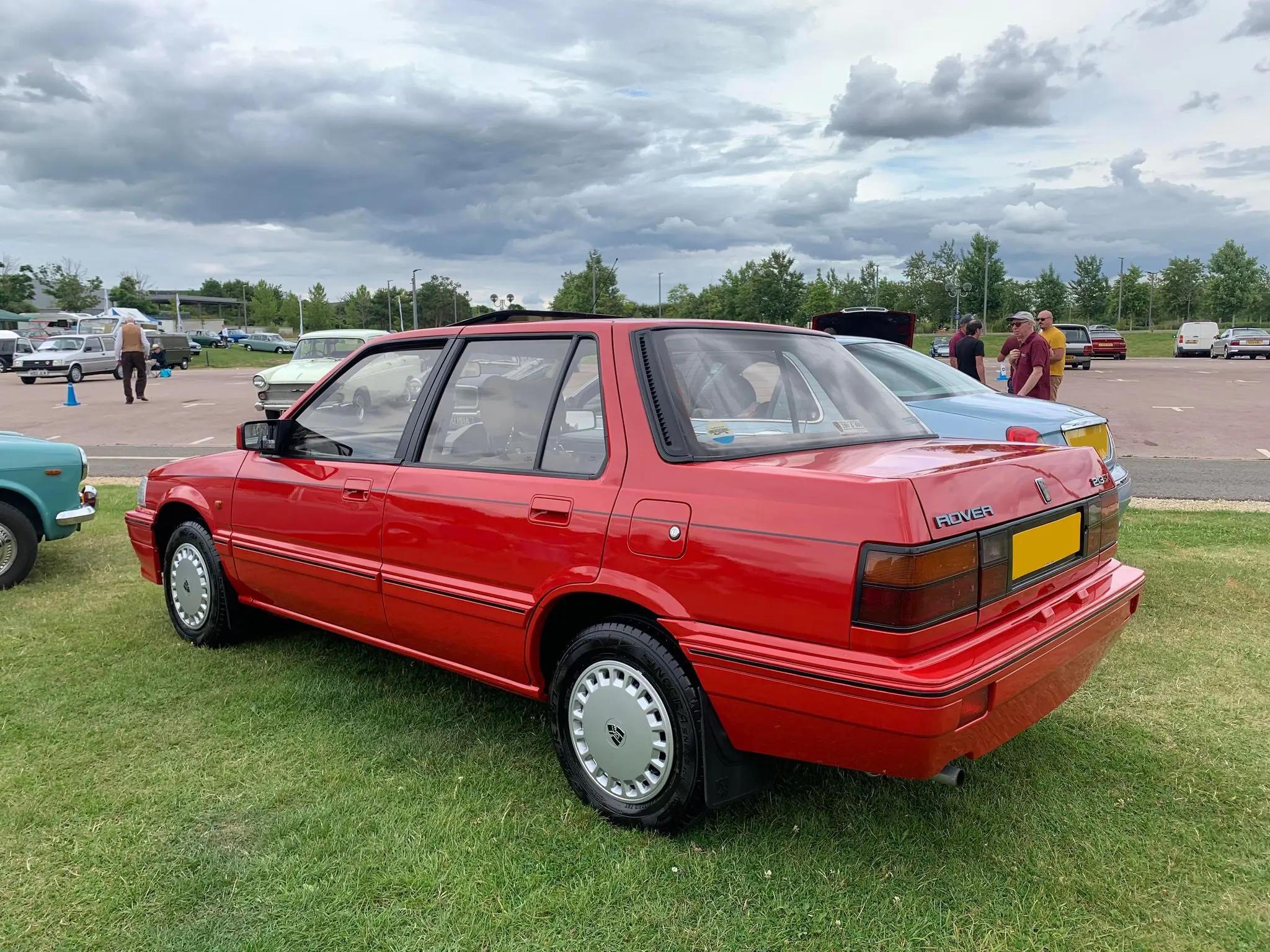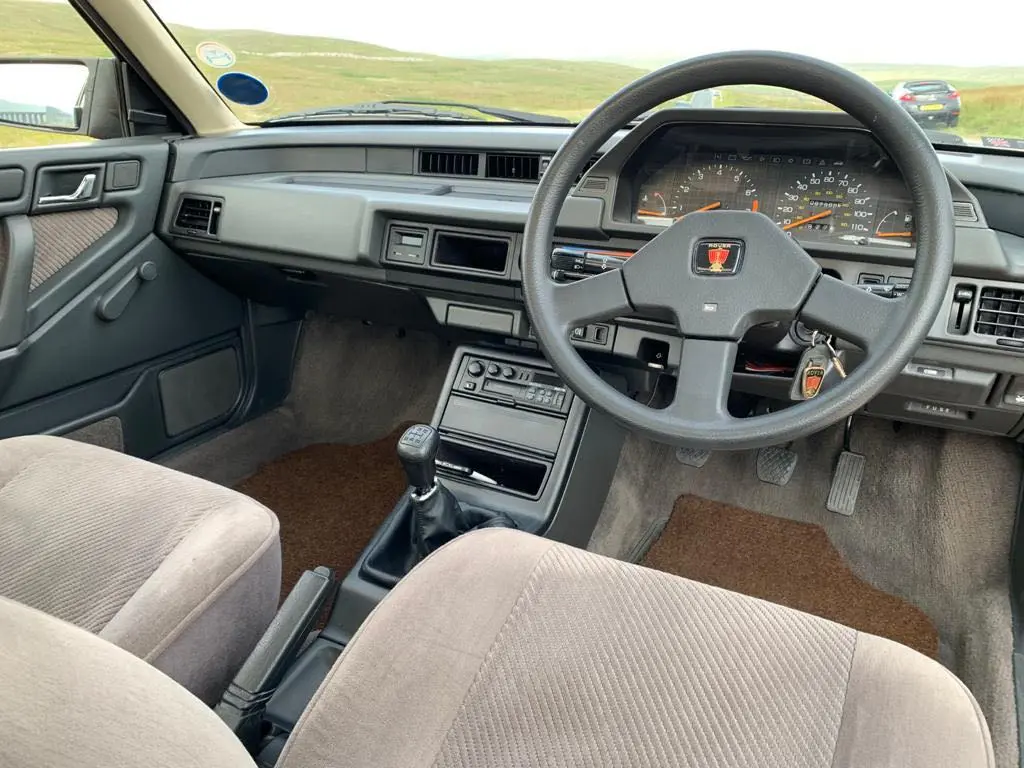MEET THE OWNER – AARON MARRS AND HIS ROVER 213 SX
19 September 2024
A friend told me the 213 was looking for a new home as the long-term owner was giving up driving. From memory, he had owned it since it was about six years old. The owner’s son, whom I liaised with, wanted it to go to a good home as it had been such a well-loved car – and also well known in the area – rather than see it sold and run into the ground.
Aaron Marrs is the proud owner of what is believed to be the only Rover 213 SX on the road. “Cast your eyes over the sleek, all body colour coachwork,” urged the brochure back in 1989, further tempting motorists with “comfortable seats, with diagonal velvet facings” and “stylish wheel trims”.

By then, the SD3-Series Rover was five years old, and when the 213 made its bow on June 19, 1984, it was almost another world. A pint of milk cost 22 pence, and petrol was £1.87 a gallon. BBC2 screened the last episode of The Young Ones, Two Tribes by Frankie Goes To Hollywood topped the charts and various British Leyland executives awaited the public reception of the Triumph Acclaim’s successor.
For the SD3’s launch was not without controversy. First, it was the first compact Rover since the 1927–1947 Ten. Second, it marked the demise of the Triumph badge on cars. By 1981, the Acclaim was the sole model to use the famous name, and Harold Musgrove, the Chairman of the Austin Rover division, regarded British Leyland’s marques as “a legacy of confusion”.
Third, and probably most importantly from a sales perspective, there remained the concern that Rover enthusiasts might not accept a car based on the Honda Ballade. Seventy per cent of the SD3 was to be made in the UK, with the engine, transmission, suspension, dashboard and steering wheel imported from Japan.

However, while the Acclaim had demonstrated that BL could make cars to Honda’s standards, certain die-hards muttered that a Viking-badged Ballade could never be a “real Rover”. Mindful of such concerns, the sales copy promised the 213 was:
powered by a relatively small and thrifty engine of advanced design, yet embodying all the high quality, refined luxury and sheer driving pleasure for which the marque is so justly renowned.
Such admittedly over-the-top writing did not impress The Telegraph, which was very dismissive about the claim “Bred to Be a Rover”. However, the reviewer did regard it as “in many ways a joy to drive”, and appreciated a more spacious cabin than the Acclaim. Sue Baker of The Observer complained about the ride and advised readers to wait for the 216, which made its bow in 1985. Fortunately, Motor Sport was more complimentary:
The new 200-series are likened to the Rover Ten of old – unfortunately the Ten was not originally a very good car! Forget all this and I concede that the Rover 213 SE is excellent transport.

Meanwhile, Car grumbled: “One searches in vain for real class.” However, they did note: “Inside, the British contribution to the 213 is obvious. The seats and upholstery are as English as after-work pints and roasts on Sunday.” The latest Rover appealed to motorists who regarded the Ford Orion as ever-so-faintly downmarket and drove a highly polished Triumph Toledo ten years earlier.
The R8 replaced the SD3 in October 1989, and when Aaron purchased his 213 SX in 2021, it was obvious work was needed. However, he wanted to do right by the car and the previous owner and bring it back to its former glory. Much work was devoted to the Rover, from new sills, arches and door repairs undertaken at the body shop to paint correction and repairing the leaky sunroof between Aaron and his friends: “It really has been a labour of love.” As for the 213’s road manners:
It is lovely to drive, easily keeps up with modern traffic, and I go everywhere in it. I live in Cheshire and I’ve been to see my friends in Northumberland in it a few times, and to various car shows across the country. I love the way it’s quite floaty compared to modern cars. The 213 gets quite a lot of attention wherever it goes. I think being very boxy and bright red makes it stand out. One time at a petrol station a lady pulled up and said she had one years ago and still misses her old 213 to this day. She was so pleased to see one in the flesh again and that it was being cherished, remarking: “They did like to rust, but it was so reliable and comfortable.”

Yet, despite the SD3’s appeal, and its importance to British Leyland history, Aaron thinks:
Sadly, it does not seem to have the respect that is its due, and only those who had them when new look back fondly at them. Most people remember them for rotting away in front of you – which sadly they do if you see the before restoration picture of mine – although I think most of the cars from that era did. It would be nice to see the 200 gain more of a following like the Montego, the Maestro and the Metro.
The 200 deserves to be remembered as a crucial model for BL, leading to their focus on the Rover brand – and that is before we mention Keeping Up Appearances. Most importantly, once the restoration work was completed, Aaron took the Rover back to the previous owner: “Ivor and Rita had had the car since 1994 and enjoyed many happy adventures in it over the years. Naturally, Ivor was delighted to see it once more, commenting: ‘It’s looking a lot shinier, again.’”
With thanks to Aaron Marrs for his time and permission to use the images in this blog.
